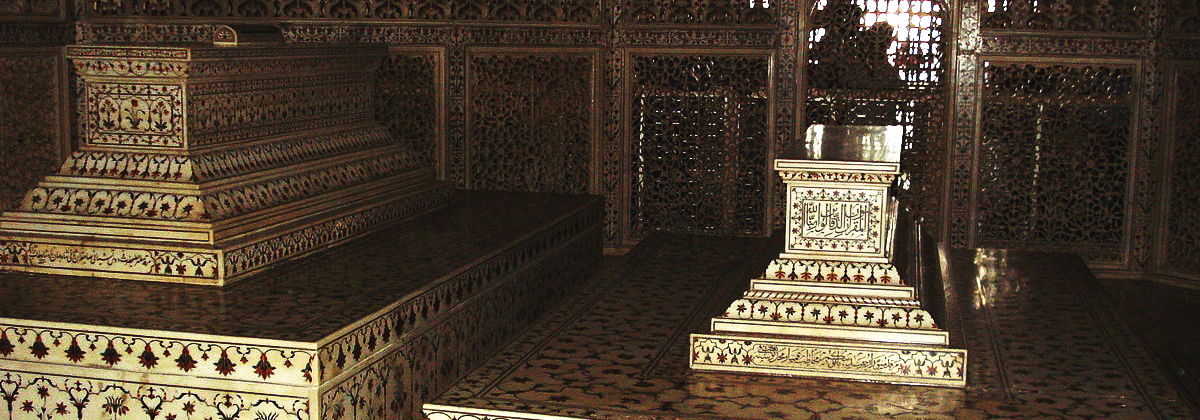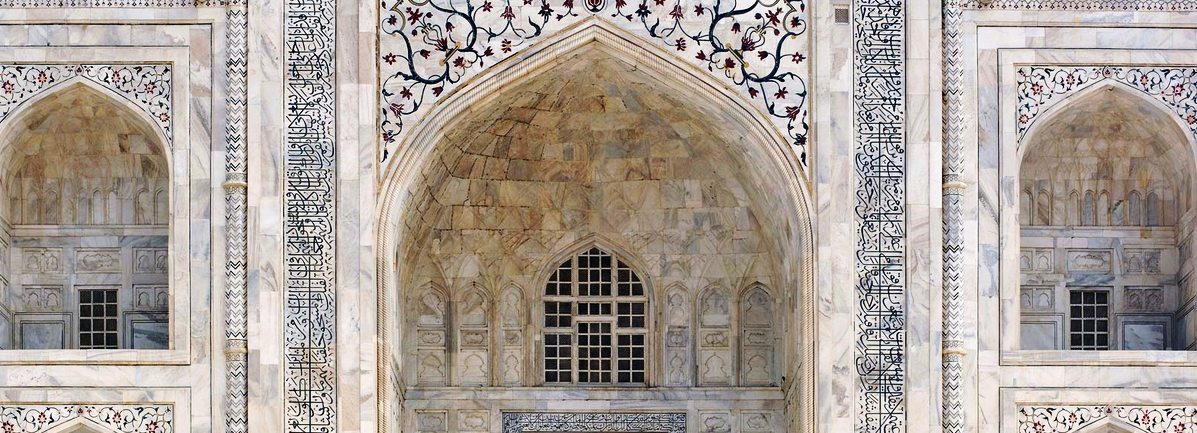The Taj Mahal - A Teardrop on the Face of Eternity
For three and half centuries the exquisite marble lattice work, which forms the airy walls of the tomb, has allowed the dust-laden, hot blasts of summer and the scented breath of the monsoon to caress the cold stone of the grave that lies therein. My footsteps echo off the cold marble floor and whisper eerily around the lofty dome above, and in so doing I feel a tear in the fabric of time – as the ghostly echoes whisper insistently from the dark void above, so too did they whisper of those who trod this very floor three and half centuries ago.

There is a crisis in the camp tonight. At sunset the call from the royal tent had gone out for the surgeon, and the royal bodyguard encamped adjacent to the imperial enclosure are party to the calls for hot water and more light. A camel, led by a wizened man in a loin cloth, arrives, piled high with brush and firewood, and soon the sparks lift into the inky night and dark shadows cast themselves against the canvas of the royal enclosure.
Glittering Orion wheels impassively across the sky
Somewhere in the desert darkness a wolf howls, impassive to the army encamped nearby and the drama unfolding at its centre. A woman’s agonised cries cut through the steady murmur of an army of voices, and the crackle of fires and the occasional whicker of a restless cavalry horse. As the hours wear on, the cries come more often and the entire encampment is in thrall to the events unfolding in the Emperor’s tent. Glittering Orion wheels impassively across the sky, descending now towards the western horizon, his inexorable descent marking the passing of the hours.
Word spreads like wildfire through the encamped army – the Queen is dead
Ears prick up to the first lusty wails of a newborn child, causing the sentries to stir and minutes later the surgeon appears, silhouetted against the ruddy light of the fires in the imperial enclosure, his tunic bloodied and the weariness set deep in his sunken eyes. A quick conversation with the sentry and the word spreads like wildfire through the encamped army – the Queen is dead. Mumtaz Mahal, the Jewel of the Palace, and most beloved of the Moghul Emperor: confidant, wife, mother and companion, has crossed over to eternity.
The last request to her husband was to promise her a monument to their love
She was carrying the 14th child of Emperor Shah Jahan and has been his constant companion, even in the theatre of war - but this campaign against the Lodi princes of the Deccan to secure the southwestern reaches of the empire is to be her last. Moghul power in India is at its zenith, the first conquests begun by Emperor Babur in 1535 and now being consolidated by his great-great grandson. In the cold grey light of dawn a sorrowing emperor issues the order to break camp and begin the long march northeast to Agra and the Moghul heartland, thoughts of war forgotten. Legend has it that on her deathbed Mumtaz’s last request to her husband was to promise her a monument to their love – little did she realise to what ends her husband would go to fulfill that promise.
‘A teardrop on the face of eternity’
The Taj Mahal is the fulfillment of that promise and is the world’s greatest monument to love, standing in all its splendour on the banks of the Yamuna River. ‘A teardrop on the face of eternity’ is how Rabindrath Tagore, India’s Nobel laureate described it. A diminutive sarcophagus lies in the centre of the edifice - all there is to remind us that this is first and foremost the final resting place of a queen. Standing in the cool half-light of the interior of the mausoleum, one is easily distracted by the grandiosity of the surrounding edifice.
.....as the ghostly echoes whisper insistently from the dark void above
For three and half centuries the exquisite marble lattice work, which forms the airy walls of the tomb, has allowed the dust-laden, hot blasts of summer and the scented breath of the monsoon to caress the cold stone of the grave that lies therein. My footsteps echo off the cold marble floor and whisper eerily around the lofty dome above, and in so doing I feel a tear in the fabric of time – as the ghostly echoes whisper insistently from the dark void above, so too did they whisper of those who trod this very floor three and half centuries ago.

Shunning the pleasures of a slow, grubby Indian commuter train
This was my second trip to Agra to see the splendours of the Taj. All in all, things have got a bit affluent and organised in India since my first visit in the early 1990’s; helped along of course by a little more affluence and increased budget from my side too. Shunning the pleasures of a slow, grubby Indian commuter train, with India piling on and off in glorious bedlam, we took the fast, air-conditioned, clean and comfortable affair from Delhi to Agra, which set us down in two hours at the Cantonment station.
Firm handling and hard bargaining will get you a taxi ride to town
It wasn’t however half as much fun as the 5 hour hob-nob with the locals which I enjoyed the first time round. Of course Agra is the most touristy town in India and touts and rip-off artists swarm around any new arrival like flies around the proverbial, but don’t let that put you off – firm handling and hard bargaining will get you a taxi ride to town and a clean room. We dumped our packs and lay on our beds as the temperatures outside climbed to 45 degrees and planned our itinerary for the next 3 days.
Before the sun rains down its mighty hammer blows on the back of your head
Travelling in India between April and August is not for the faint-hearted – daytime temperatures are murder and the mosquitoes equally so. No matter which season you visit, do yourself a favour and pound on those massive wooden doors to the Taj’s entrance pavilion in the dawn and demand entrance. The early morning coolth is bliss before the sun rains down its mighty hammer blows on the back of your head, and early arrival gets you front row seats to the spectacle of the morning rays turning the dome into an ethereal glow that is almost impossible to describe. And the added bonus is that you will be way ahead of the crowds, which allows you to stand alone in the centre of the mausoleum and listen to the whispers of eternity echo from the dome above.
The dome towers above the vast flatness of the Indian plains
From 1631 to 1648 architects, engineers, masons, artists and an army of labourers toiled to build the Taj. Sixty one metres high and 25 metres across, the dome towers above the vast flatness of the Indian plains. Every section of the central edifice is clad in shimmering white Makrana marble hewn from the quarries of Nagaur, 550 km distant. The mausoleum itself stands within a formally laid out, walled garden which is accessed through a pavilion at the southern end. From this pavilion one looks northwards towards the dome, which is our familiar vista of the Taj and perhaps the most photographed view in the world.

Where only the view of the Taj and his memories accompanied him to his death
Fact and fiction are intertwined; as only they are able in this land of myth and mystery, and legend has it that the hands of the artisans were chopped off once the work was complete so that never again could another Taj Mahal be built. Another is that Shah Jahan planned a black Taj Mahal on the opposite bank of river as his own mausoleum – a mirror image of the monument to his wife. Where legend ends and truth begins is open to debate, but what is known is that Shah Jahan was deposed by his son Aurangzeb, who incarcerated him in the Agra Fort approximately 5 km upstream, where only the view of the Taj and his memories accompanied him to his death.
Many tears must have been shed by the mothers and widows
There is much sadness surrounding the Taj, not all of which is associated with Mumtaz and Shah Jahan. Many tears must have been shed by the mothers and widows of those who died building the monument. And die they certainly did, for to haul the huge blocks of marble and red sandstone the 550 kilometres from the Makrana quarries, and then to drag them up ramps and scaffolding would have caused its fair share of casualties, not to mention those who succumbed to heat and disease over the 21 year construction period.
'....so wasteful, so decadent and in the end so cruel that it is painful to be there for very long'
Then there were the taxes that were levied to pay for the construction work which would have placed an additional burden on the peasantry. The Taj can thus be construed as not only a memorial to the queen of an empire but to those who toiled to bring it into being. India’s more recent Nobel laureate, V.S. Naipaul, described the Taj as:“so wasteful, so decadent and in the end so cruel that it is painful to be there for very long. This is an extravagance that speaks of the blood of the people.”

Against the backdrop of fading empires, wars, famines, floods and disease
Controversial but undoubtedly beautiful, it has stood impassively for over three and a half centuries against the backdrop of fading empires, wars, famines, floods and disease.
Achieving some modicum of immortality
The Taj is the high tide mark in an often nondescript sea of human endeavour and perhaps that was Shah Jahan’s genius; to focus the efforts of ordinary men and women to build a monument not only to Mumtaz, but to themselves, and in so doing achieving some modicum of immortality.
Walk through the sacred stillness of a tomb
So, do yourself a favour and buy yourself an air ticket to Delhi, take a slow train to Agra and then take an even slower walk through the sacred stillness of a tomb, and marvel at the wonder of it all. But I must add a warning though – India will seduce you to the extent that your ruin will be complete – it will become a life-long love affair, driving you to distraction as only an affair of the heart can.
The best time to go is post monsoon (September) and before the spring (March) when temperatures are moderate and the weather relatively dry.
If this resonates with you and you think it may be valuable to others, please share.
Want to come adventuring? Who wouldn't? So sign up for our newsletters and stay informed when we launch new courses or go off on happy wanderings.
A promise - no spam, no nonsense, no passing on of your details
So looking forward to exploring with you


That was a great article. Very evocative.